The Importance of Pearl Jewelry: An In-Depth Study

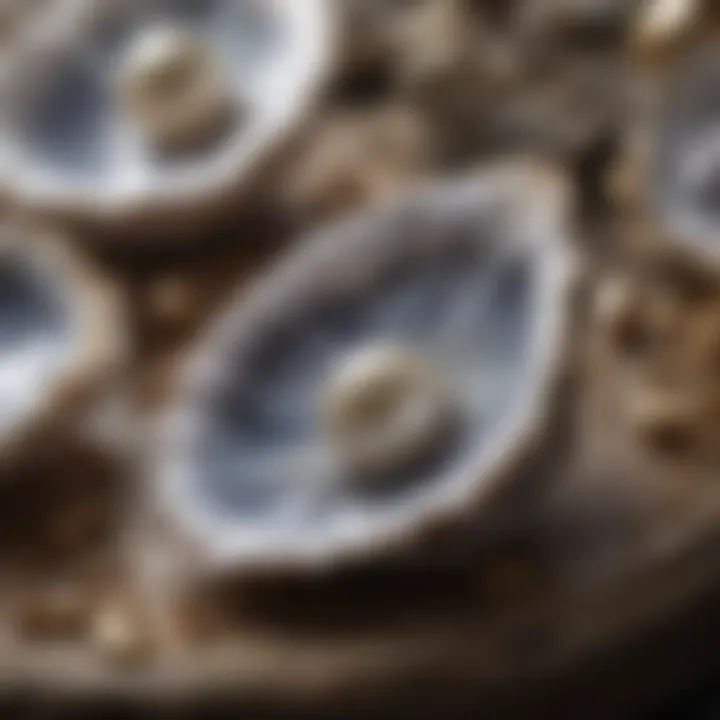
Intro
Pearl jewelry carries a legacy as timeless as the ocean from which its exquisite gems emerge. These lustrous orbs, often regarded as symbols of purity and elegance, possess a significance that transcends mere aesthetics. In both ancient and contemporary cultures, pearls have woven intricate tales of love, status, and spirituality. From regal crowns to romantic gifts, the allure of pearl jewelry is ever-present. In this exploration, we will delve into the fascinating world of pearls, their formation, their role throughout history, and their continuing significance today.
Gemstone Overview
Definition and Characteristics
Pearls stand apart in the realm of gemstones. Unlike the usual crystalline structure that other gems possess, pearls are organic gems formed entirely within living mollusks. When an irritant, like a grain of sand, finds its way into the shell of an oyster or mussel, the creature reacts by secreting layers of nacre, a substance that coats the irritant for protection. This natural process results in the formation of pearls, characterized by their unique luster and soft glow.
Pearls can be classified into several types, primarily categorized by their origin: natural and cultured. Natural pearls form without human interference, while cultured pearls are produced with the help of human intervention, typically through the insertion of a nucleus into the mollusk.
Classification of Gemstones
While pearls are considered gemstones, they fall into a unique category distinct from traditional stones. Gemstones can be broadly classified based on several criteria:
- Natural versus Synthetic: Natural gemstones occur in nature, whereas synthetic stones are man-made.
- Precious versus Semi-Precious: Historically, the classification includes diamonds, rubies, sapphires, and emeralds as precious; others like amethyst and garnet as semi-precious.
- Organic versus Inorganic: Organic stones come from living organisms (like pearls), while inorganic stones are purely mineral.
Historical Significance
Ancient Uses and Cultural Importance
Throughout history, pearls have been highly valued. Ancient Egyptians, Greeks, and Romans adorned themselves with pearls, considering them a symbol of wealth and nobility. Cleopatra reportedly wore beautiful pearl ornaments, and the Romans believed they offered protection in battle.
In various cultures, pearls were often entwined with mythology and religion. For instance, pearls in Hindu culture symbolize wisdom and purity, being associated with the goddess Lakshmi. Similarly, in Christianity, they represent heaven and are often depicted in religious art.
Myths and Legends Surrounding Pearls
Legends revolving around pearls abound and add layers of depth to their allure. For example, many cultures believed pearls formed from the tears of the gods. There are stories of pearls carrying the voices of mermaids or being the result of moonlight captured in the sea. These narratives fuel the fascination and mystique surrounding pearl jewelry, contributing to its esteemed place in our hearts.
"In the depths of the ocean, the pearl is metaphorically the breath of a dream waiting to surface, unveiling the beauty hidden in irritation."
The rich tapestry of cultural significance and historical context surrounding pearls sets an intriguing stage for their journey through time. With layers of meaning and captivating stories, pearl jewelry embodies not just beauty but also profound narratives that continue to resonate in modern society.
Preamble to Pearl Jewelry
The allure of pearl jewelry captivates many, serving not merely as adornment but as a bridge to centuries of culture, history, and artistry. These gems, fashioned by nature, carry stories within their lustrous surfaces. This article aims to peel back the layers of significance surrounding pearl jewelry, digging into not just what makes these gems beautiful, but the depth of their cultural meaning and personal value.
Pearl jewelry's importance extends beyond its aesthetic appeal. For gemstone enthusiasts and collectors, pearls symbolize not just beauty but a legacy. They have adorned royalty throughout history and have been pivotal in rituals across cultures. Understanding the significance of pearl jewelry prepares the reader to appreciate its nuances, from its historical roots to contemporary designs.
Understanding Pearls
Pearls stand out in the gemstone world due to their unique formation. Unlike other gems developed through geological processes, pearls are organic creations. They form inside mollusks as a defense mechanism against irritants such as parasites or grains of sand. In essence, a pearl is nature's way of turning an unwelcome visitor into something stunning. This process is not merely a tale of beauty; it reflects resilience—a lesson embedded in every strand of pearls.
With every pearl possessing a story, it’s interesting to note the variety available. From classic white to vibrant colors, the spectrum of pearls caters to different tastes. There's a richness in this variety that speaks to individual expression, whether someone opts for the timeless elegance of a strand of Akoya pearls or the bold vibrancy of Tahitian pearls. This diversity in color and shape adds layers to their appeal.
Pearls as Organic Gems
What sets pearls apart is their organic origin. As organic gems, they evoke a connection to nature that synthetic materials cannot mimic. This aspect elevates pearls into a unique category of precious stones; they are seen as living gems. When one wears pearls, they carry the essence of the sea, a tangible link to the natural world.
Consumers today often seek authenticity in products, making the organic nature of pearls attractive. They symbolize not just beauty but also a return to nature, aligning with a growing trend towards sustainable fashion. In times where fast fashion dominates, pearls represent a timeless choice.
"Pearls are the only gems formed within a living creature; they’re a sweet reflection of life’s organic essence."
Understanding pearls as organic gems allows one to appreciate their value beyond mere ornamentation. They serve as a reminder of nature's artistry and resilience. When selected with care, pearls can be a lasting treasure, a piece of jewelry that tells a story of both elegance and natural beauty.
Historical Significance of Pearls
The historical significance of pearls is woven into the fabric of various cultures throughout the ages. It is not merely a story of beauty; pearls have often represented power, wealth, and social standing. By examining ancient civilizations, the role of pearls in royalty and nobility, and the cultural rituals that involve these exquisite gems, we uncover how pearls have captivated humanity for centuries.
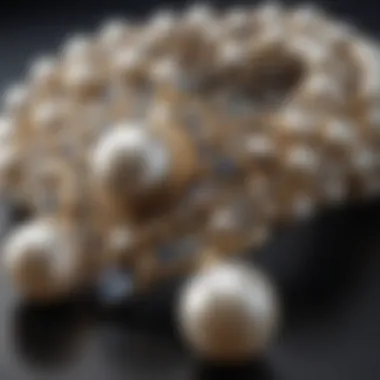
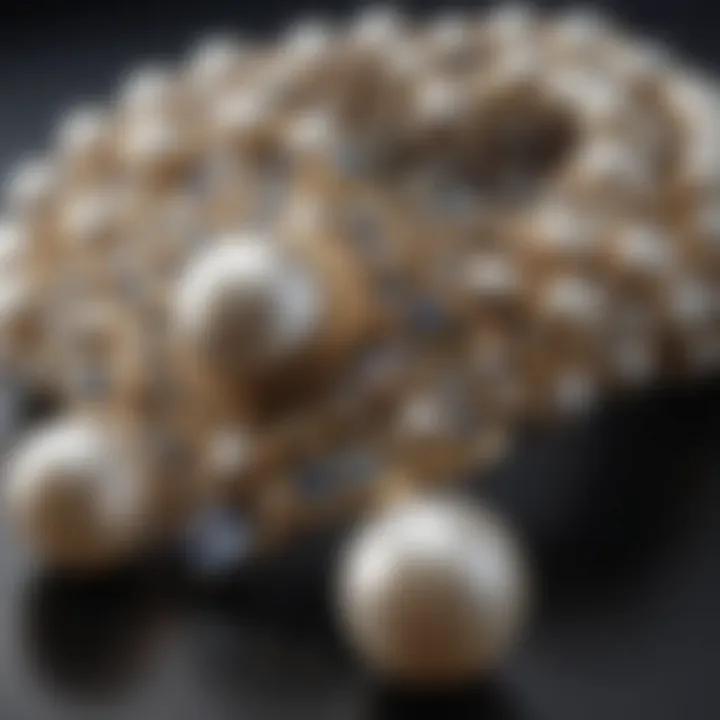
Ancient Civilizations and Pearls
In the cradle of civilization, ancient societies like the Egyptians, Greeks, and Romans recognized the exceptional allure embodied in pearls. Archaeological findings suggest that pearls were prized possessions as far back as 5000 BCE. The Egyptians adorned the tombs of their pharaohs with pearl jewelry, believing that it would provide protection in the afterlife. In fact, the oldest known pearl dating back to this era was found in the tomb of the Persian princess, demonstrating the gem's revered status.
The Greeks also held pearls in high regard, associating them with the goddess of love and beauty, Aphrodite. In ancient Greece, brides would wear pearls, which symbolized both love and purity, during their weddings, reflecting the pearls' connection to new beginnings. On the other hand, the Romans viewed pearls as the ultimate status symbol. It is said that Julius Caesar established a law where only the ruling class was permitted to wear virgin pearls, elevating their exclusivity to the highest realms of society.
Pearls in Royalty and Nobility
Throughout history, many royal families used pearls not just as adornments but as a demonstration of their wealth and influence. The famous Marie Antoinette, queen of France, wore elaborate pearl necklaces that marked her as a fashion icon of her time but also served as a political tool, presenting a façade of grace amid turmoil.
Similarly, Queen Elizabeth I of England is remembered for her lavish use of pearls, which she wore to enhance her status as both a monarch and a symbol of virtue. The pearls were often paired with more colorful gemstones, creating a striking contrast that amplified their nobility.
"Pearls were often referred to as the 'teardrops of the gods,' holding divine significance in the eyes of many historical figures."
Even today, we see pearls associated with royalty in various cultures. Consider the famous Imperial Pearl Necklace of Japan, which belonged to Empress Shōken. Such historical pieces serve as reminders of the enduring relationship between pearls and nobility, showcasing not just beauty but also a lineage of power.
Cultural Rituals Involving Pearls
Beyond their aesthetic appeal, pearls have been deeply embedded in cultural rituals across the globe. In many Asian cultures, pearls are seen as lucky charms and are often gifted to newborn girls, symbolizing good fortune and the promise of prosperity.
In Hindu culture, pearls are associated with astrological beliefs. Wearing pearls is said to bring harmony and balance in one's life, often recommended during specific planetary alignments. During weddings in various cultures, pearls are frequently used as part of the bridal attire, connecting the gemstone to the themes of purity, love, and commitment. The act of gifting pearl jewelry has underscored its significance in many cultural traditions, often being passed down through generations as cherished heirlooms.
Furthermore, in the Islamic tradition, pearls are mentioned in the Qur'an as among the treasures of paradise, amplifying their spiritual and cultural weight.
Symbolism of Pearls Across Cultures
Pearls hold a significant place in various cultures around the world, celebrated not just for their beauty but also for their deep-rooted symbolic meanings. The allure of pearls goes beyond mere aesthetics; they represent profound concepts that resonate with human experiences. Understanding the symbolism attached to pearls allows us to appreciate not only their physical beauty but also their cultural narratives. This section aims to explore the different dimensions of pearl symbolism, highlighting key themes such as purity, femininity, and spirituality.
Representation of Purity and Innocence
In many cultures, pearls are often termed the "gems of purity". Their formation process—nurtured within the protective layers of a mollusk—conveys an idea of something refined and pure, untouched by the external world. This is particularly evident in Western traditions, where pearls are commonly associated with brides on their wedding days. The white hue of pearls symbolizes a new beginning and embodies innocence, a perfect reflection of bridal purity.
Moreover, ancient beliefs viewed pearls as talismans that could ward off evil and protect young girls. Their association with innocence often translates to offerings of pearls to newborns—gifts symbolizing hope and purity for their future. For many, the understanding of pearls transcends mere ornamentation and tips into the realm of sacred or protective meaning, revealing how deep-seated cultural narratives shape our interpretations of these natural treasures.
Connection to Femininity and Womanhood
Pearls have long been seen as a symbol of femininity, showcasing the qualities traditionally linked to women. The connection arises from their organic formation, which reflects the delicate balance of strength and beauty inherent in women. In literature and art, pearls often stand as metaphors for the complexities and dualities of womanhood.
For example, in many cultures, the act of presenting pearls signifies respect and admiration for women. In Japan, the gifting of pearls marks significant life milestones for women—like their coming-of-age ceremonies. Furthermore, pearl jewelry has prominently featured in feminist discourse, often highlighting the empowerment tied to women's identities and their independence. In this way, pearls not only adorn but also encapsulate a spirit of feminine strength and resilience.
Spiritual and Metaphysical Associations
Pearls are often linked with various spiritual and metaphysical beliefs. Many cultures view them as a source of wisdom—reflecting the inner journey one undergoes through life. Their luster represents the illumination of truth and understanding, guiding individuals toward higher consciousness.
In Hinduism, for instance, pearls are associated with the Moon and have therapeutic properties, believed to calm the mind and enhance intuition. They symbolize emotional balance and harmony, making them powerful in spiritual practices and meditative routines.
Additionally, pearls have a role in crystal healing, where they're thought to connect individuals to the energies of the ocean and the feminine aspect of nature. Many enthusiasts use pearls in spiritual rituals to enhance their inner sense of peace and understanding of self.
"Pearls bridge the gap between the earth and the cosmic, a testament to the duality of life—rooted yet ethereal."
In unraveling the tapestry of pearl symbolism across cultures, we discover a wealth of meanings that elevate these jewels beyond adornment, highlighting their role as vessels of history, identity, and spiritual significance.
Pearls in Modern Jewelry Design
In the current landscape of jewelry design, pearls have evolved from traditional pieces to integral elements in contemporary creations. While often associated with classic elegance, modern designers have found innovative ways to incorporate pearls into their works, transforming them into symbols of both sophistication and creativity. This section delves into the significance of pearl jewelry today, looking closely at trends, innovative designs, and the role of celebrities in popularizing pearl fashion.
Trends in Pearl Jewelry
Over the last few years, the pearl trend has seen a remarkable resurgence. Where previously pearls were reserved for formal occasions or vintage styles, they are now being embraced in new, unexpected ways.
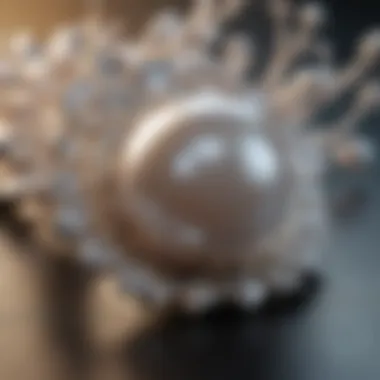
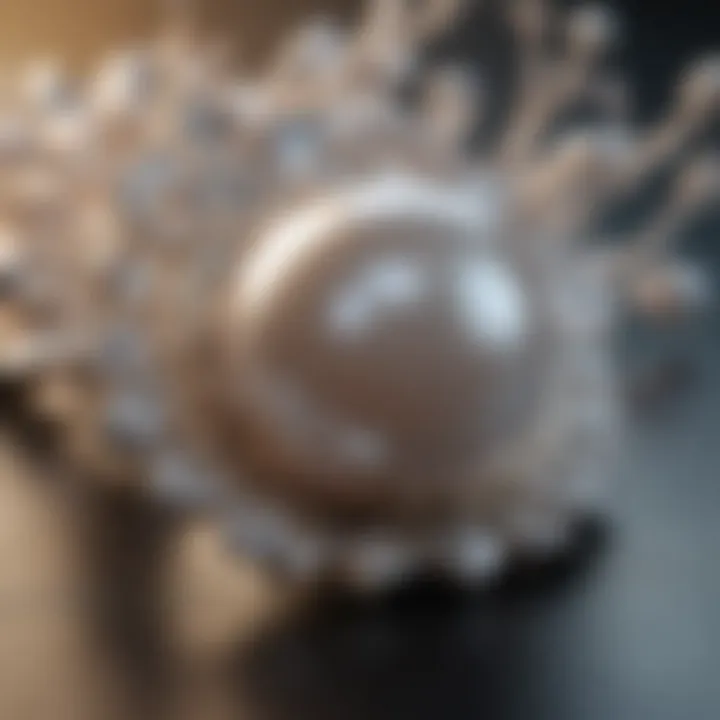
Some notable trends include:
- Layering: Wearing multiple pearl necklaces of varying lengths creates a chic and textured look. This technique emphasizes the versatility of pearls, allowing for personalization according to one’s style.
- Mixed Materials: Today, pearls are often combined with other materials like leather, gold or even fabric. This fusion can invoke a sense of modernity while retaining the classic beauty of pearls.
- Minimalist Styles: In contrast to the opulent motifs of past generations, many contemporary designs embrace minimalism. Simple pearl studs or single strand necklaces can convey elegance without overwhelming the wearer.
Through these trends, it becomes clear that pearls are not just relics of the past but adaptable gems that resonate with modern aesthetics.
Innovative Designs and Techniques
Creativity knows no bounds in modern jewelry design, and pearls have been at the forefront of this innovation. Designers are experimenting with various techniques to highlight pearls in distinctive fashions.
For instance, the use of unconventional shapes and settings has brought a breath of fresh air to traditional designs. Baroque pearls, known for their irregular shapes, are now celebrated for their uniqueness, often featured alongside crystal or semi-precious stones for an avant-garde look.
In addition, technology has played a critical role in advancing pearl jewelry design. 3D printing has enabled designers to create intricate settings that were previously unimaginable. More than just a trend, these techniques open up new possibilities for customization, ensuring that each piece tells a unique story.
Celebrities and Pearl Trends
The influence of celebrities on jewelry trends cannot be overstated, and pearls are no exception. Over the past few years, various high-profile figures have donned pearl jewelry in public appearances, thereby solidifying its status in modern fashion.
For example, fashion icons like Rihanna and Zendaya have been seen wearing bold pearl statement pieces that challenge the conventional perceptions surrounding pearls. Their daring choices inspire fans and followers to embrace pearls in unexpected ways.
Moreover, social media platforms such as Instagram and TikTok amplify these trends, creating a space where jewelry lovers can share their unique styles and ideas involving pearl jewelry. This continual highlighting by celebrities not only enhances the desirability of pearl pieces but also cements their place in the modern jewelry boxes of many.
Pearls today reflect a blend of tradition and innovation, bridging the gap between classic and contemporary styles.
In summary, pearls in modern jewelry design signify more than mere adornment; they symbolize adaptability and creativity. Emerging trends, groundbreaking designs, and celebrity endorsements contribute to a renaissance of pearl jewelry that appeals to collectors, enthusiasts, and fashionistas alike. As these elements converge, they carve out a beloved position for pearls in contemporary style, ensuring their relevance for generations to come.
The Science of Pearls
Understanding the science behind pearls is crucial not just for enthusiasts but also for collectors and jewelers looking to appreciate the intricacies that make these organic gems so unique. The realm of pearls is one that merges nature with meticulous craftsmanship, thus providing an avenue for exploring both geology and aesthetics. By grasping the natural processes of how pearls form, the distinctions between types, and how they are graded, one gains a richer insight into their value and desirability.
Formation of Natural Pearls
Natural pearls form in the wild through a fascinating biological process. When an irritant, such as a grain of sand, enters an oyster or mollusk, the creature defends itself by secreting layers of nacre, a combination of aragonite and conchiolin. Over time, these layers build up, resulting in the creation of a pearl. Natural pearls are rare, as suitable conditions for such occurrences are few and far between. Some tides, water temperatures, and dwelling microorganisms contribute to the chances of formation, making natural pearls almost like a treasure hunt.
This process is both a wonder and a mystery. Though it might seem straightforward, the varied factors, including the health of the host mollusk and environmental conditions, play pivotal roles in shaping the final appearance of the pearl. Some pearls might be perfectly round, while others might exhibit a more irregular shape, each bringing its own charm. Furthermore, natural pearls often take years, sometimes decades, to develop, adding to their intrigue and value.
Cultured vs. Natural Pearls
Navigating the scene of pearl types brings us to a key distinction: cultured versus natural pearls. While natural pearls rely on chance and nature, cultured pearls are intentionally created through human intervention. A nucleus, often made from shell or plastic, is inserted into a mollusk, prompting it to produce nacre around this foreign object. This method has led to a sustainable way of cultivating pearls, allowing for greater availability in the market.
Cultured pearls, however, are not a lesser substitute. They come with a variety of qualities and can even rival natural pearls in luster and beauty. The most common types of cultured pearls include Akoya, Tahitian, and South Sea, each differing in characteristics, colors, and shapes due to the specific types of oysters used.
Both types serve different purposes and appeal to various segments of the jewelry market. Collectors may seek out the deep history and rarity of natural pearls, while jewelry designers might prefer the diversity and availability of cultured options, allowing for more artistic variation in their creations.
Grading and Classification of Pearls
Understanding how pearls are graded is vital for anyone involved with them, whether for investment, collection, or creation. Pearls are assessed based on several criteria: luster, which refers to the shine and reflectiveness; surface quality, noting imperfections or blemishes; shape, which can range from perfectly round to baroque; color, as pearls come in a spectrum of hues; and size, which typically varies from small to very large.
These parameters create a grading system, often employing the work of experts to arrive at a pearl's classification, the metrics of which can change with consumer trends and scientific advancement. This grading helps establish a pearl’s market value and desirability (and) can drastically influence collectors' decisions in acquisitions.
"The beauty of pearls lies in their natural imperfections; each one tells a different story through its uniqueness."
Caring for Pearl Jewelry
Caring for precious pearl jewelry is more than just an act of maintenance; it’s about preserving the stories and beauty embedded within each piece. Pearls, being organic gems, require a gentle touch and careful thought in their upkeep due to their unique characteristics. Understanding how to care for these gems will not just prolong their beauty, but also maintain their value, ensuring they can be cherished for generations.
Cleaning Techniques
Cleaning pearl jewelry needs a tailored approach given the delicacy of pearls. The most straightforward method involves using a soft, lint-free cloth. Simply wipe the pearls gently after each use to remove any oils or dirt. Sometimes, even a bit of perspiration can dull their luster.
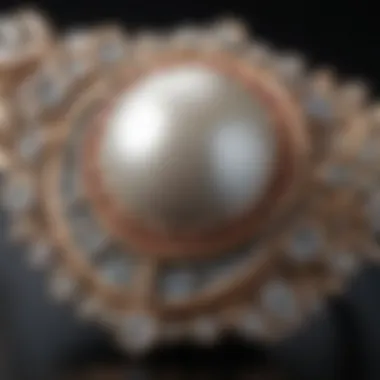
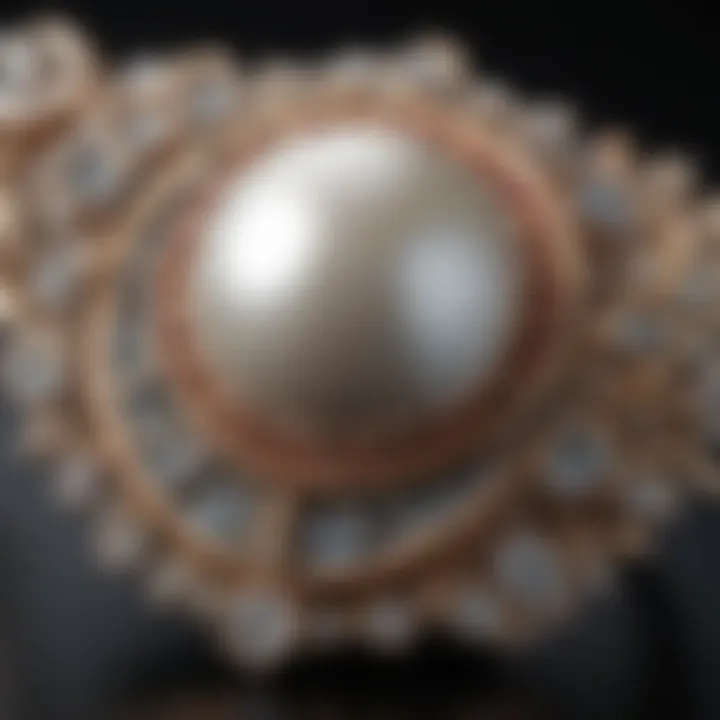
- Water: For a deeper clean, a mixture of lukewarm water and a mild soap can be helpful. Remember to avoid harsh chemicals or abrasive materials that could scratch the surface. Simply dip the cloth into the solution and then wipe the pearls clean, ensuring that the cloth is not too wet.
- Drying: After cleaning, let the pearls air dry. Do not expose them to direct sunlight or use heat sources to speed up drying, as this could cause potential damage.
"Gentle care ensures the enduring beauty of pearls, safeguarding their luster and charm like a warm embrace."
Storage Considerations
Where and how you store pearl jewelry is crucial for maintaining its quality. Pearls should never be thrown together in a jewelry box with other gemstones; they can scratch easily. Instead, consider these options:
- Soft Pouches: Use individual soft pouches or wrap them in a soft cloth. This prevents them from coming into contact with any sharp objects.
- Avoid Plastic: While it might seem simple to store pearls in plastic bags, this can trap moisture and potentially lead to degradation.
- Separate from Other Jewelry: Always store pearls separately from diamonds, rubies, or other gemstones that could cause scratching.
Avoiding Damage and Wear
Taking proactive steps to avoid damage enhances the lifespan of your pearl jewelry.
- Wearing: Wear your pearl jewelry last, after applying perfumes or lotions. This simple forgotten habit can save them from unwanted chemicals that may tarnish their sheen.
- Environmental Considerations: Avoid exposing them to harsh environments like pools or spas, where chlorine can wreak havoc.
- Routine Check-ups: Regularly inspect your pearl strands for fraying threads; a simple stitch can save a valuable piece. Consider having them restrung every few years, especially if you wear them often.
Caring for pearl jewelry requires a thoughtful approach. By adhering to these practices, you’re not just looking after beautiful items but also nurturing a legacy that can be appreciated by future generations.
Investing in Pearls
Investing in pearls is not merely about aesthetics or fashion; it encapsulates a world of potential financial growth and personal enrichment. The pearl market, while not as widely recognized as diamonds or emeralds, has its own rhythm, driven by trends, consumer shifts, and rarity. Understanding this landscape can be essential for anyone looking to make informed decisions about buying pearl jewelry.
Market Trends in Pearl Jewelry
The market trends for pearl jewelry have seen shifts reminiscent of the changing tide at sea. Recent years have brought a resurgence in the popularity of pearls, largely as consumers increasingly seek unique and sustainable alternatives to mass-produced items. The advent of social media has also played a crucial role; platforms like Instagram flaunt pearls worn by influencers and celebrities, igniting public interest.
Barriers to entry in the pearl market are relatively low, which means that there's space for both established and emerging designers. Trends now lean towards more avant-garde and customizable pieces, blending traditional pearl aesthetics with modern design concepts.
Moreover, the growth of the eco-conscious consumer has led to a higher demand for ethically sourced pearls. Consumers want assurance that their purchases support sustainable practices, boosting the market for responsibly farmed pearls.
Value Assessment of Pearls
Assessing the value of pearls involves more than just their surface appeal. Several factors come into play:
- Type: Natural pearls command a higher price than cultured counterparts due to their rarity.
- Quality: The luster, surface quality, and shape are crucial. Pearls with a high surface quality and those that exhibit a beautiful, reflective sheen tend to be more valuable.
- Size: Larger pearls not only make a bolder statement but also fetch higher prices.
- Color: While traditionally white pearls have been dominant, colored pearls—like Tahitian or golden South Sea pearls—are increasingly sought after, adding to their value.
Understanding these aspects allows collectors and investors to buy with confidence. The right pearl can be a gold mine hidden within an oyster shell, waiting to be appreciated.
Future of Pearls in the Market
Looking forward, the pearl market has intriguing potential. The cultural mythology surrounding pearls—linked with beauty, wealth, and sophistication—remains strong. As the market begins to welcome a new generation of buyers, there is a chance for pearls to regain their former glory while also breaking new ground.
With the global move towards sustainability, the future may see the rise of pearls cultivated in ways that respect marine ecosystems. This environmental focus could attract not just jewelry enthusiasts but also investors looking for sustainable options.
"In many ways, investing in pearls is like planting a seed; with the right care, it can bloom into something beautiful and valuable over time."
Overall, investing in pearls can act as both a personal adornment and a strategic financial decision. By understanding market trends, conducting thorough value assessments, and recognizing future potentials, enthusiasts and collectors can find joy and investment growth in these iridescent gems.
End
The conclusion serves as a critical lens through which to view the entirety of this exploration into pearl jewelry. This section wraps up the findings, emphasizing the blend of history, culture, and the enduring charm that pearls have maintained through centuries. The significance of pearl jewelry is not merely in its aesthetic appeal but also in the rich tapestry of meanings it weaves across diverse cultures and periods.
Reflecting on the Timelessness of Pearls
Pearls possess a certain timeless allure that remains unscathed by changing trends. They have been revered in various societies since ancient times, symbolizing everything from purity to opulence. Unlike many gemstones, the essence of pearls lies in their organic formation, which inspires a deep reverence towards nature.
The radiance of a pearl is often likened to the reflection of the moonlight on water—a metaphor that captures the essence of its beauty and grace. As generations come and go, the love for pearls continues to flourish. They hold a unique place in both history and personal narratives; they find their way into wedding traditions, heirloom pieces, and even modern fashion statements. For enthusiasts, collectors, and designers alike, pearls endure as a testament to elegance and sophistication. Their ability to complement various styles demonstrates their versatility, making them a constant in jewelry collections.
Final Thoughts on Pearl Jewelry's Meaning
The meaning of pearl jewelry transcends mere ornamentation. Each pearl tells a story, encapsulating the natural processes that birthed it, as well as the cultural significance it has accrued over time. When individuals choose pearl jewelry, they often do so with a sense of belonging—connecting to a lineage, a tradition, or a personal moment in their lives.
The nuances in pearl jewelry’s significance highlight a symbiotic relationship between personal expression and cultural heritage. In modern times, as consumers become increasingly aware of sustainability and ethical sourcing, pearls—from sea to strand—reflect this shift. Investing in pearl jewelry not only serves as a financial decision but also embodies a commitment to preserving the artistry behind these natural gems.
In closing, pearl jewelry is much more than a mere accessory. It is a rich narrative of nature, culture, and individual expression. As the world evolves, pearls continue to inspire awe and admiration, making them timeless treasures.
Their lustrous beauty and cultural depth ensure that pearls will forever be an integral part of our jewelry boxes and our hearts.







